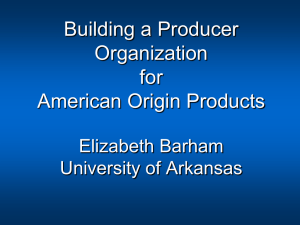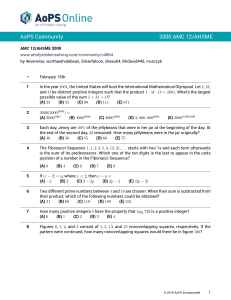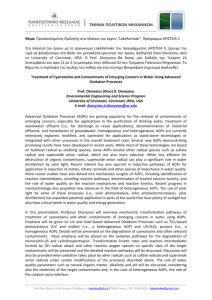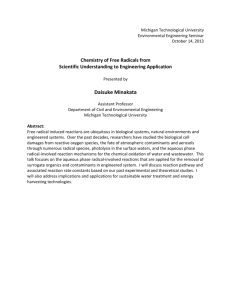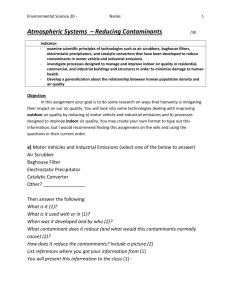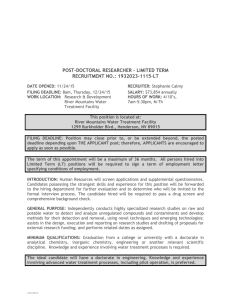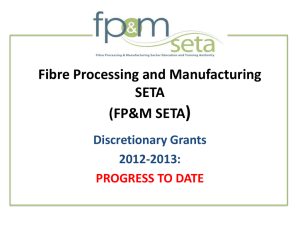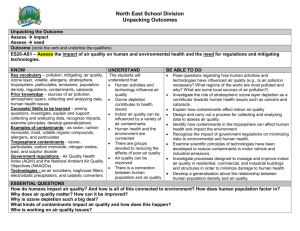PhD Scholarship
advertisement
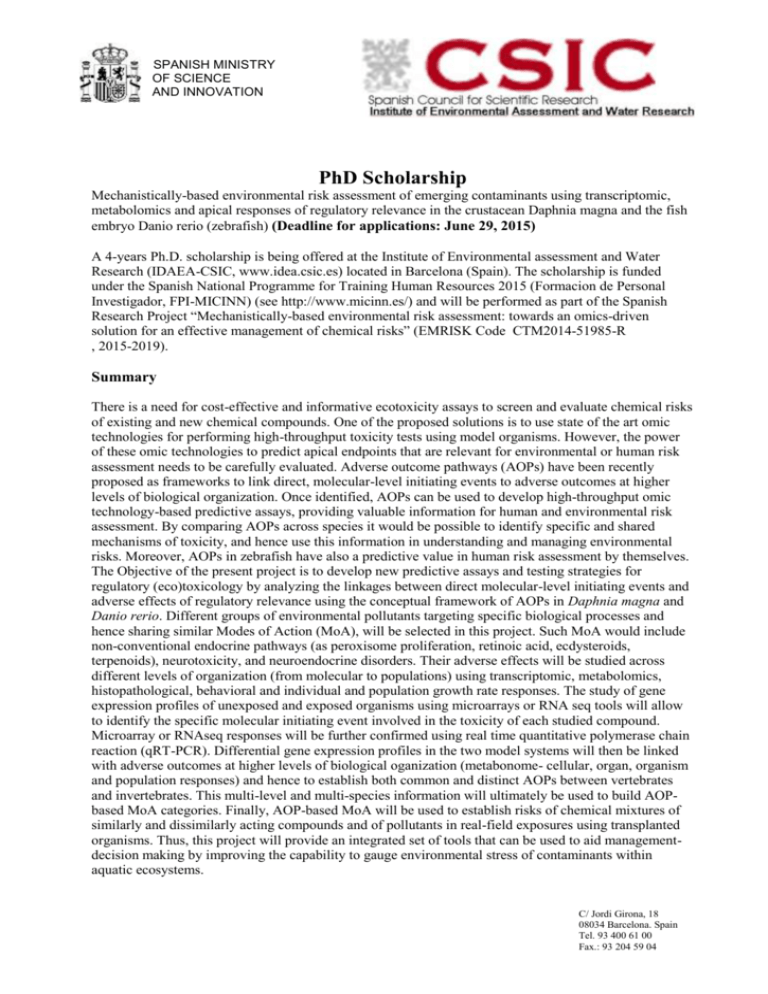
SPANISH MINISTRY OF SCIENCE AND INNOVATION PhD Scholarship Mechanistically-based environmental risk assessment of emerging contaminants using transcriptomic, metabolomics and apical responses of regulatory relevance in the crustacean Daphnia magna and the fish embryo Danio rerio (zebrafish) (Deadline for applications: June 29, 2015) A 4-years Ph.D. scholarship is being offered at the Institute of Environmental assessment and Water Research (IDAEA-CSIC, www.idea.csic.es) located in Barcelona (Spain). The scholarship is funded under the Spanish National Programme for Training Human Resources 2015 (Formacion de Personal Investigador, FPI-MICINN) (see http://www.micinn.es/) and will be performed as part of the Spanish Research Project “Mechanistically-based environmental risk assessment: towards an omics-driven solution for an effective management of chemical risks” (EMRISK Code CTM2014-51985-R , 2015-2019). Summary There is a need for cost-effective and informative ecotoxicity assays to screen and evaluate chemical risks of existing and new chemical compounds. One of the proposed solutions is to use state of the art omic technologies for performing high-throughput toxicity tests using model organisms. However, the power of these omic technologies to predict apical endpoints that are relevant for environmental or human risk assessment needs to be carefully evaluated. Adverse outcome pathways (AOPs) have been recently proposed as frameworks to link direct, molecular-level initiating events to adverse outcomes at higher levels of biological organization. Once identified, AOPs can be used to develop high-throughput omic technology-based predictive assays, providing valuable information for human and environmental risk assessment. By comparing AOPs across species it would be possible to identify specific and shared mechanisms of toxicity, and hence use this information in understanding and managing environmental risks. Moreover, AOPs in zebrafish have also a predictive value in human risk assessment by themselves. The Objective of the present project is to develop new predictive assays and testing strategies for regulatory (eco)toxicology by analyzing the linkages between direct molecular-level initiating events and adverse effects of regulatory relevance using the conceptual framework of AOPs in Daphnia magna and Danio rerio. Different groups of environmental pollutants targeting specific biological processes and hence sharing similar Modes of Action (MoA), will be selected in this project. Such MoA would include non-conventional endocrine pathways (as peroxisome proliferation, retinoic acid, ecdysteroids, terpenoids), neurotoxicity, and neuroendocrine disorders. Their adverse effects will be studied across different levels of organization (from molecular to populations) using transcriptomic, metabolomics, histopathological, behavioral and individual and population growth rate responses. The study of gene expression profiles of unexposed and exposed organisms using microarrays or RNA seq tools will allow to identify the specific molecular initiating event involved in the toxicity of each studied compound. Microarray or RNAseq responses will be further confirmed using real time quantitative polymerase chain reaction (qRT-PCR). Differential gene expression profiles in the two model systems will then be linked with adverse outcomes at higher levels of biological oganization (metabonome- cellular, organ, organism and population responses) and hence to establish both common and distinct AOPs between vertebrates and invertebrates. This multi-level and multi-species information will ultimately be used to build AOPbased MoA categories. Finally, AOP-based MoA will be used to establish risks of chemical mixtures of similarly and dissimilarly acting compounds and of pollutants in real-field exposures using transplanted organisms. Thus, this project will provide an integrated set of tools that can be used to aid managementdecision making by improving the capability to gauge environmental stress of contaminants within aquatic ecosystems. C/ Jordi Girona, 18 08034 Barcelona. Spain Tel. 93 400 61 00 Fax.: 93 204 59 04 SPANISH MINISTRY OF SCIENCE AND INNOVATION KEY WORDS: risk assessment, omic, transcriptomic, metabolomic, Daphnia, zebrafish, contaminants, water, system biology The Ph.D. candidate will study transcriptomic and metabolomics responses of individuals exposed to emerging contaminants and will relate them with apical enpoints of regulatory relevance (mortality, malformations, behaviour, growth, reproduction, population growth rates). The project EMRISK is highly multidisciplinary and is linked with the EU-ERC project CHEMAGEB. The project involves chemists, mathematicians, bio-informatics, molecular biologists and ecotoxicologists from around the world. The position will last for 4 years (approx. starting date: January 2016), with an approx. net monthly salary of 1100€. The fellowship includes annual short stays (2-6 months) in research centers abroad. The candidate is expected to publish research results in international peer-reviewed journals and attend scientific meetings. Candidates must have a bachelor's and MSc degree (to be finish during this present academic course 2014-2015) in Biology, Environmental Sciences, Biomedical Sciences, Molecular Biology, Biochemistry, Pharmacy, Chemistry or similar, and preferably have (or being completing) an official M.Sc. on Environmental Sciences, Molecular Biology, Biochemistry or similar. Fluency in English will be positively evaluated. Candidates must demonstrate initiative, responsibility and independence at work. If you are interested, please send an e-mail to Ph.D. Carlos Barata (cbmqam@cid.csic.es), including a summary of the curriculum vitae and a brief description of your experiences and grades, publications if any, and a brief statement of scientific interests. Formal applications must be processed through the web portal of the Spanish Science Ministry (http://www.idi.mineco.gob.es/portal/site/MICINN/menuitem.dbc68b34d11ccbd5d52ffeb801432ea0/?vgnextoid=fe d2bf0be2c6d410VgnVCM1000001d04140aRCRD&vgnextchannel=11f35656ecfee310VgnVCM1000001d04140aR CRD) The forms to apply for the scholarship will be available during June 2015. Check on the above link for the exact dates for the formal application. Sincerely Carlos Barata, cbmqam@cid.csic.es Tenured scientist C/ Jordi Girona, 18 08034 Barcelona. Spain Tel. 93 400 61 00 Fax.: 93 204 59 04
